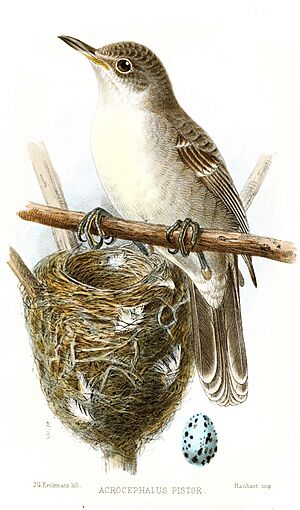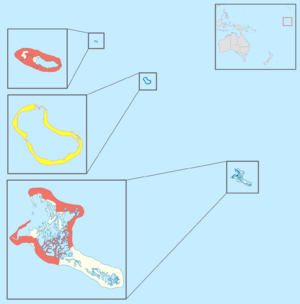Bokikokiko facts for kids
Quick facts for kids Bokikokiko |
|
|---|---|
 |
|
| Illustration by J. G. Keulemans (1883) | |
| Conservation status | |
| Scientific classification | |
| Genus: |
Acrocephalus (bird)
|
| Species: |
aequinoctialis
|
 |
|
| Approximate distribution
Range Extinct Depicted: Teraina (top), Tabuaeran (middle), and Kiritimati (bottom), Northern Line Islands, Kiribati, Oceania |
|
| Synonyms | |
|
|
The bokikokiko, also called the Kiritimati reed warbler or Christmas Island warbler, is a small bird. It belongs to the warbler family, called Acrocephalidae. This special bird lives only on two islands: Kiritimati and Washington Island. Both islands are part of Kiribati, a country in the Pacific Ocean.
Scientists believe there are about 2,500 bokikokiko birds left. Sadly, their numbers are going down. This bird is currently listed as endangered on the IUCN Red List. This means it is at a very high risk of disappearing forever.
Contents
Why the Bokikokiko is Endangered
The bokikokiko faces several big dangers that make its population shrink.
Threats from Introduced Animals
One major problem comes from animals that humans brought to the islands. These include:
- Pigs: They can disturb the bird's nests and feeding areas.
- Rats: These small animals can eat the birds' eggs and chicks.
- Feral cats: Cats that live in the wild are a very serious threat. They hunt and kill the bokikokiko birds.
Dangers from Climate Change
Climate change is another big worry for the bokikokiko. As the Earth gets warmer, sea levels are rising. This is a huge problem for islands like Kiritimati and Washington Island. Rising seas can flood the low-lying areas where these birds live. This destroys their homes and reduces the places where they can find food.
Different Kinds of Bokikokiko
Scientists sometimes divide the bokikokiko into slightly different groups, called subspecies. These groups have small differences and live in different parts of the islands.
- The Acrocephalus aequinoctialis aequinoctialis group was first described in 1790. It lives across the northern Pacific Line Islands.
- The Acrocephalus aequinoctialis pistor group is found on Teraina and Tabuaeran islands.
Bokikokiko and People
For a long time, the bokikokiko has been important to the people living on these islands.
- Cultural Significance: This bird has special meaning in local traditions.
- Valued Feathers: Its feathers were once highly valued. People used to hunt these birds because they believed their feathers had special properties.
Images for kids



